Despite severe drought, cash receipts for every major crop and livestock commodity were higher in 2021 than in 2020.
For many of the livestock and crop industries, higher prices relative to 2020 (especially in the latter part of the year) explain the increased revenues. Cash receipts for livestock and crops in 2021 are estimated at $8.8 billion. Cash receipts for milk, Idaho’s leading agricultural commodity by revenue, were estimated as 3% higher than in 2020. Those for potatoes, Idaho’s highest-revenue crop, were estimated as 8% higher relative to 2020.
Livestock and crop cash receipts for 2021 were estimated as 9% higher relative to 2020. Net farm income for 2021 was estimated as $2.39 billion, which is 8% lower than in 2020. This lower net income value relative to 2020 remains greater than the 10-year average and is the third-highest value in the past 10 years. The decline in net income from 2021 to 2020 is largely due to lower federal government payments and higher operating expenses. Total expenses are estimated as up by 8% relative to 2020; at $7.84 billion, this value is the highest in the past 10 years.
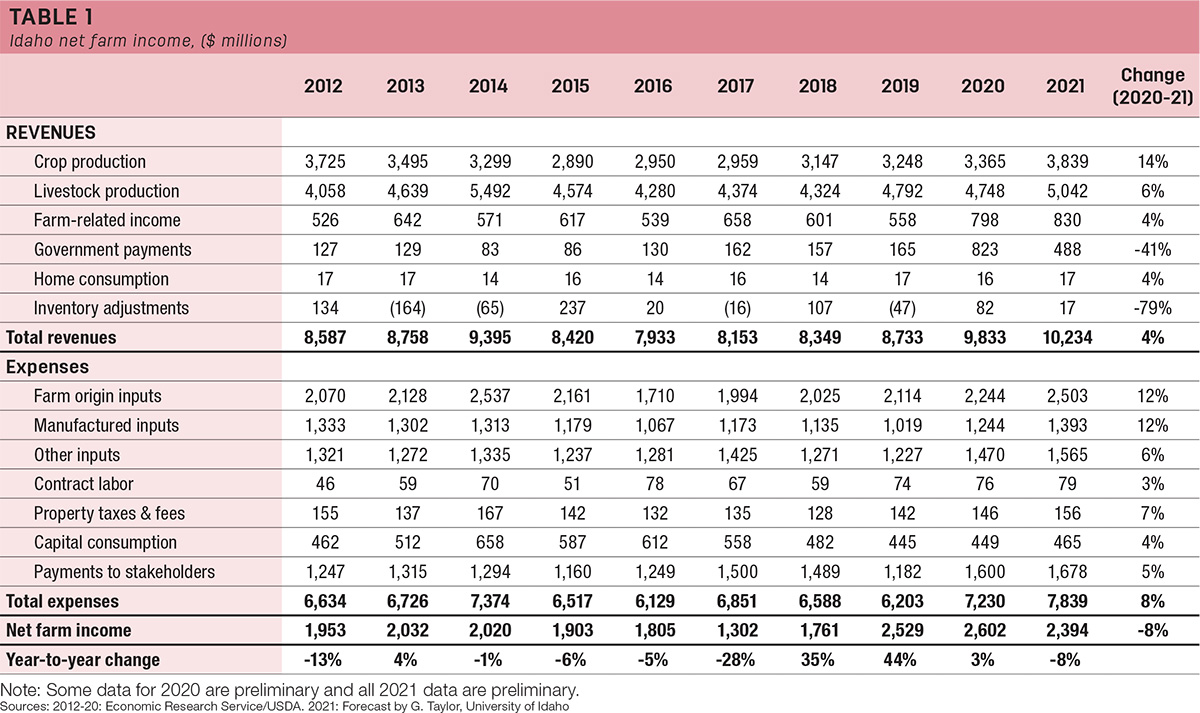
Highlights
- Exports from farms and food processors create a ripple effect throughout Idaho’s economy, ultimately helping to make agribusiness one of Idaho’s largest industries. About $1 of every $6 in sales is directly or indirectly created by agribusiness.
- Idaho, the top potato producer, scored record-high potato revenues in 2012. In 2021, estimated cash receipts surpassed $1 billion. Wheat and hay follow in second and third place with estimated 2021 cash receipts of $560 million and $554 million, respectively.
- In 2021, Idaho garnered its second-highest milk revenues, ranking third in U.S. for milk production. With estimated cash receipts for 2021 of $3.06 billion, revenues from milk production are the highest of all agricultural commodities produced in Idaho, almost its highest tally in the past decade. Second to milk regarding cash receipts are those from cattle and calves, which in 2021 were $1.79 billion.
- Idaho agriculture is driven largely by livestock. Cash receipts from milk, cattle and calves, and other livestock (e.g., trout) comprise over 56% of total agricultural cash receipts for 2021. Hay, silage, feed grains and the byproducts from sugarbeet and potato processing are used as feed for Idaho livestock.
- Except for 2009 – a year of disastrously poor milk prices – livestock cash receipts have surpassed crop cash receipts for every year since 2001. In 2021, livestock cash receipts are estimated to surpass crop cash receipts by more than $1.2 billion.
- Idaho’s net farm income for 2021 is estimated at $2.39 billion, which is 8% below that of 2020 but is the third-highest in the past 10 years. While livestock and crop revenues were up in 2021 relative to 2020, there were lower government payments and higher expenses.
- Federal government payments to Idaho producers in fiscal year 2021 are estimated at $488 million, a decrease of 41% from 2020. Coronavirus Food Assistance Program (CFAP) payments were $337 million, 69% of the total federal government payments for 2021.
Contribution of agribusiness to Idaho’s economy
Agribusiness is a vertically integrated industry comprising food production and processing. In providing food to national and international markets, agribusiness creates business sales and jobs throughout the Idaho economy and contributes to the state’s gross domestic product (GDP). Agribusiness export dollars ripple throughout Idaho’s economy, creating (directly and indirectly):
- 17% of Idaho’s total economic output
- 12% or one in every eight jobs in the state
- 12.5% of Idaho GDP
Idaho farm cash receipts
Idaho’s 2021 farm cash receipts are estimated to be $8.9 billion – a 9% increase from 2020’s $8.1 billion and exceeding the previous record-high of $8.8 billion from 2014.
Crop revenues in 2021 are estimated at $3.8 billion, up 14% from 2020’s $3.4 billion and 17% greater than the 10-year average. Hay (up 21%), sugarbeets (up 19%) and potatoes (up 8%) had the largest increases in cash receipts relative to 2020. Barley and wheat cash receipts were up 3%, while cash receipts from other crops declined by 1%. Revenue from crops (except sugarbeets) is recorded on a calendar-year basis and, therefore, includes a portion of the production from the previous and current year.
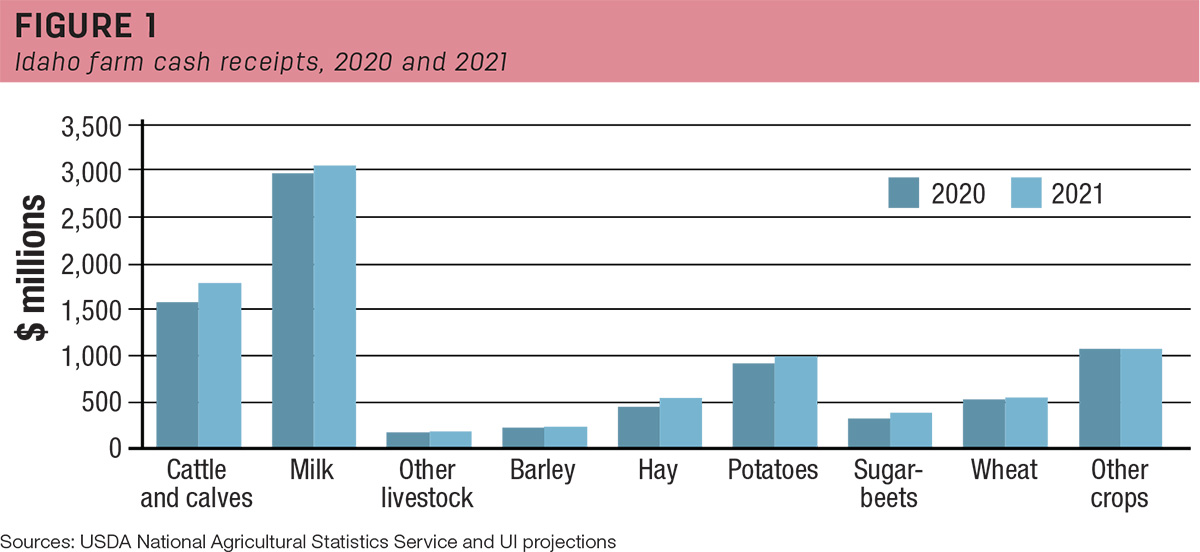
Livestock revenues are estimated at $5 billion, up 6% from 2020 and 9% greater than the previous 10-year average. Cash receipts from cattle and calves are estimated at $1.8 billion (up 13%), while those from milk of $3.1 billion and other livestock of $0.2 billion each rose 3% relative to 2020.
In real dollars (inflation adjusted to 2021), estimated cash receipts are 44% greater than the 42-year (1980-2021) average. Extreme volatility in commodity prices over the past decade has increased agricultural revenue volatility to levels not seen since the 1970s and 1980s.
Idaho net farm income
Net farm income, revenues minus costs, is the farmer’s bottom line. Revenues include cash receipts from crop and livestock sales, inventory changes, the estimated value of home consumption, government payments, machine hire and custom work, forest product sales and the imputed rental value of farm dwellings. Farm expenses include farm-origin inputs (purchased livestock, feed and seed), manufactured inputs (fertilizers, fuel and electricity) and “other inputs,” including repairs and maintenance, machine hire and custom work, marketing, storage, transportation and contract labor.
The projected 8% decrease in 2021 Idaho net farm income is the difference between a 4% increase in total revenues minus an 8% increase in total expenses. Estimated net farm income in 2021 is $2.39 billion, which is 18% greater than the 10-year average. In contrast, the USDA’s U.S. net farm income estimate for 2021 is $116.8 billion, up 23% from 2020.
Historically, net farm income is much more volatile than gross cash receipts. In four of the past 10 years, Idaho experienced double-digit swings in net farm income. The largest swings were observed between 2016 and 2019, but this volatility has moderated to some degree for 2020 and 2021. Real-dollar Idaho net farm income (inflation adjusted to 2021) was the third-highest value in the past 10 years but lower than in 2019 and 2020. Idaho real net farm income in 2021 is estimated at 47% above the previous 42-year average (1980-2021).
The overall increase in farm expenses in 2021 was attributed to 12% increases in farm origin (feed, seed and replacement livestock purchases) and manufactured (fertilizer, chemicals and fuel) inputs. All other inputs, including labor, property taxes and fees, capital consumption and payments to stakeholders all increased by percentages ranging from 3% to 7% relative to 2020.
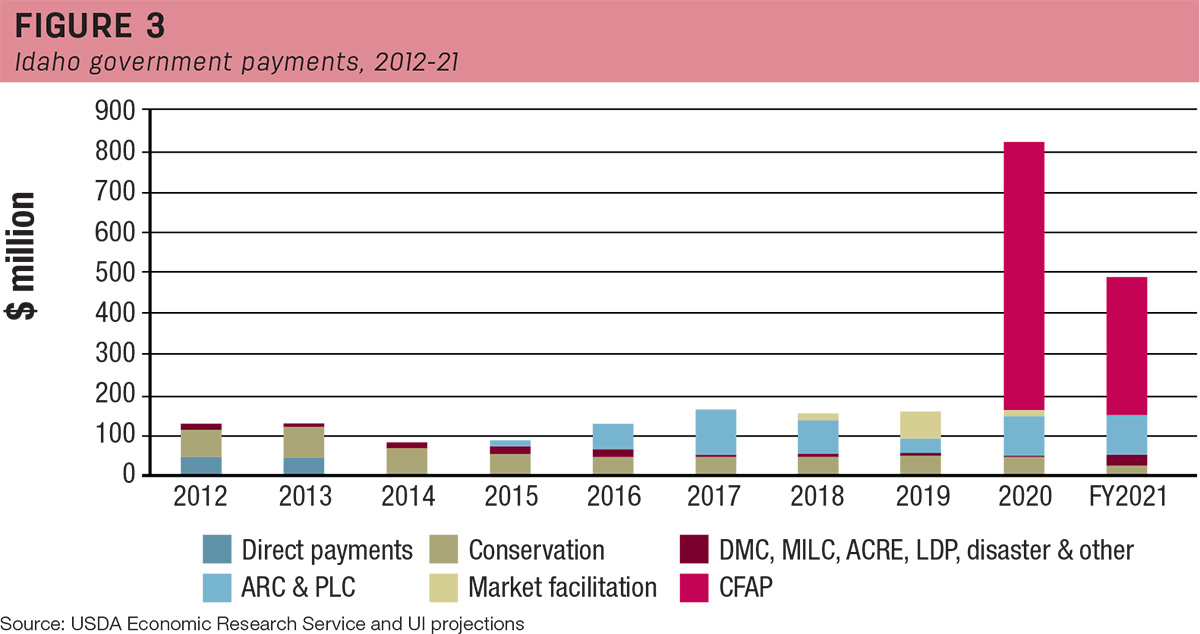
Idaho government payments
Federal government payments to Idaho agriculture in fiscal year 2021 are estimated at $488 million, which are 41% lower than in 2020 but 107% greater than the average over the previous 10 years. In 2021, CFAP payments were an estimated $337 million. Grain commodity program payments were estimated at $96 million, while conservation programs accounted for $29 million. Disaster program payments for 2021 were $26 million, the highest value in the past 10 years. Idaho is estimated to have received 0.7% of total 2021 payments to U.S. agriculture.
Idaho agriculture’s gross domestic product
Gross domestic product (GDP) measures value added, the value of output minus the value of intermediate goods and services used in production. GDP grows when farms and businesses become more efficient: increasing output while reducing use of intermediate inputs. In 2020, Idaho’s nominal GDP was approximately $84 billion, of which 3.8% was generated by farming. Farm GDP in 2020 increased 2.8% from 2019, to $3.2 billion. Over the past 24 years (1997-2020), inflation-adjusted (2012 dollars) Idaho GDP has grown over 100%, while Idaho farm GDP increased over 200%.
Idaho livestock and crop revenues
Cattle and calves
Revenue from cattle and calves is estimated at $1.8 billion in 2021, up by over 13% from 2020. A large explanatory factor for this substantial increase is higher cattle prices, which are up by more than 11% relative to 2020. This represents a substantial recovery relative to 2020, when cattle markets experienced supply chain disruptions during the height of the COVID-19 crisis.
Milk
Stronger milk prices, especially in the last months of 2021, and higher production volumes relative to 2020 increased estimated milk revenues to $3.1 billion from $3 billion in 2020. Production volumes were up 1% in 2021 compared to 2020. Milk cow inventories in Idaho as of Jan. 1, 2021, were 646,000, which is up 1.7% compared to 2020. Prices remained in a range of $17 to $21 per hundredweight (cwt) throughout 2021 and were 1% higher on average than in 2020. This relatively tight price range differed from 2020, when prices fell to below $15 per cwt for several months during the main months of the COVID-19 crisis.
Other livestock
Revenues for other livestock (e.g., trout, sheep, goats) were estimated at $191 million, a value 3% greater than in 2020. However, this level of revenue is lower than the previous 10-year average value of $219 million.
Barley
Idaho barley production in 2021 was down by an estimated 11.4 million bushels (20.7%) relative to 2020. However, prices were higher in most of 2021 and especially the last part of the year compared to 2020. These price increases were crucial for barley farmers, since harvested acres decreased by 10,000 acres and yields by 21 bushels versus 2020. With higher prices but lower production, barley revenues are estimated at $246 million, which is 3% higher than the 2020 value.
Hay
As measured by sales, hay is Idaho’s third-most-valuable crop, behind potatoes and wheat. Hay cash receipts for 2021 are projected to be $554 million, a value that is up 21% from 2020. Approximately 45% of the hay produced in Idaho is fed on the farms where it was produced rather than sold. Thus, the total value of hay production is estimated at $955 million in 2021. Idaho hay production in 2021 was an estimated 5,131 million tons, which is 139 million tons and 2.6% lower than that produced in 2020.
Potatoes
Potatoes remain Idaho’s largest crop source of farm cash receipts, with 2021 revenues estimated to be $1 billion in 2021, an 8% increase from estimated potato cash receipts for 2020. High temperatures during the growing season led to estimated potato yields of 420 cwt per acre, which are down 30 cwt per acre from 2020 yields. Harvested acreage was 15,000 greater than in 2020. Thus, total 2021 potato production is estimated to be 132 million cwt, a decline of 3 million cwt (2%) from 2020. Potato prices were lower than they were in 2020 for the beginning part of 2021 but have increased substantially (above $10 per cwt) after July 2021. The higher prices in the last months of 2021 were an important factor explaining the increase in potato cash receipts for 2021 relative to 2020.
Sugarbeets
Sugarbeet yields and sugar content for 2021 were slightly below those in 2020 as the roots were negatively impacted by excessive heat during the 2021 growing season. Sugarbeet yields in 2021 averaged 40.2 tons per acre, down from 40.5 tons per acre in 2020. Sugarbeet production for 2021 is projected to be 6.8 million tons. Harvested acres were 1,000 higher in 2021. Total sugarbeet production was slightly below that from 2020. Idaho’s projected 2021 average sugarbeet price of $58 per ton is over 9% higher than in 2020. Sugarbeet revenues are estimated to be $396 million, 19% higher than in 2020.
Wheat
Wheat was Idaho’s second-largest crop by revenue in 2021. Wheat revenues for 2021 are expected to be $560 million, up $16 million (a 3% increase) from 2020. Production was impacted greatly by the drought and high temperatures during the 2021 growing season. Wheat yields are estimated as over 29 bushels per acre lower than 2020 (down 30%). With harvested acreage down slightly, this implies a total production value of 76.5 million bushels, which is 32% lower than the 112.5 million bushel estimate for 2020. Despite the drought- and heat-related production shortfall, wheat prices in 2021 have been greater than those in 2020 for the full year, especially since August 2021. Average wheat prices for 2021 are up 27% from 2020’s prices.

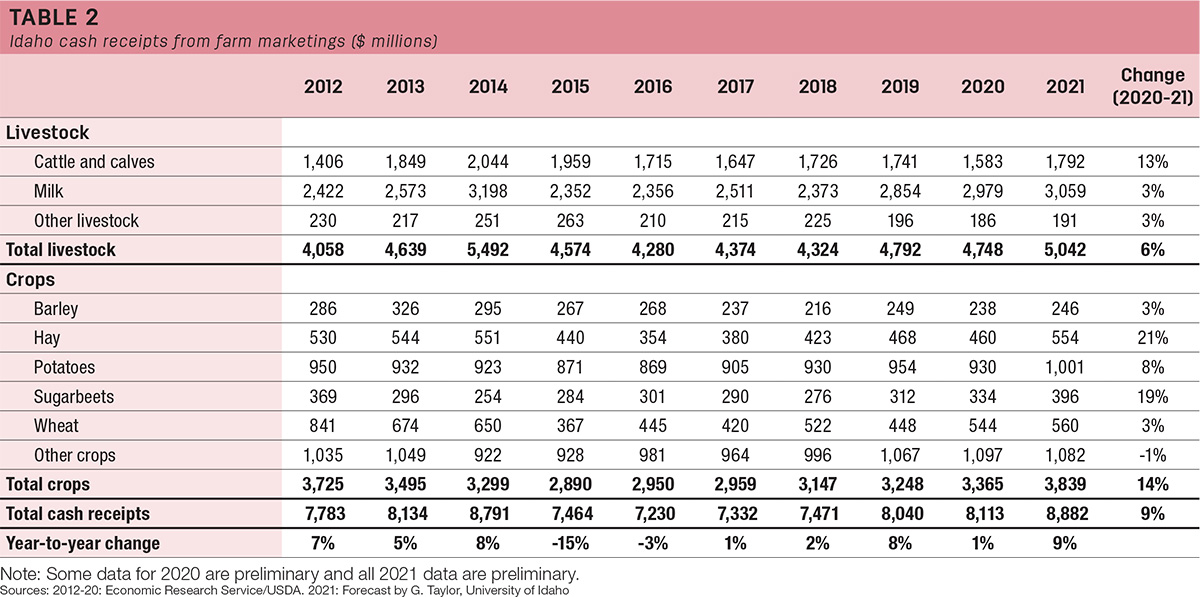
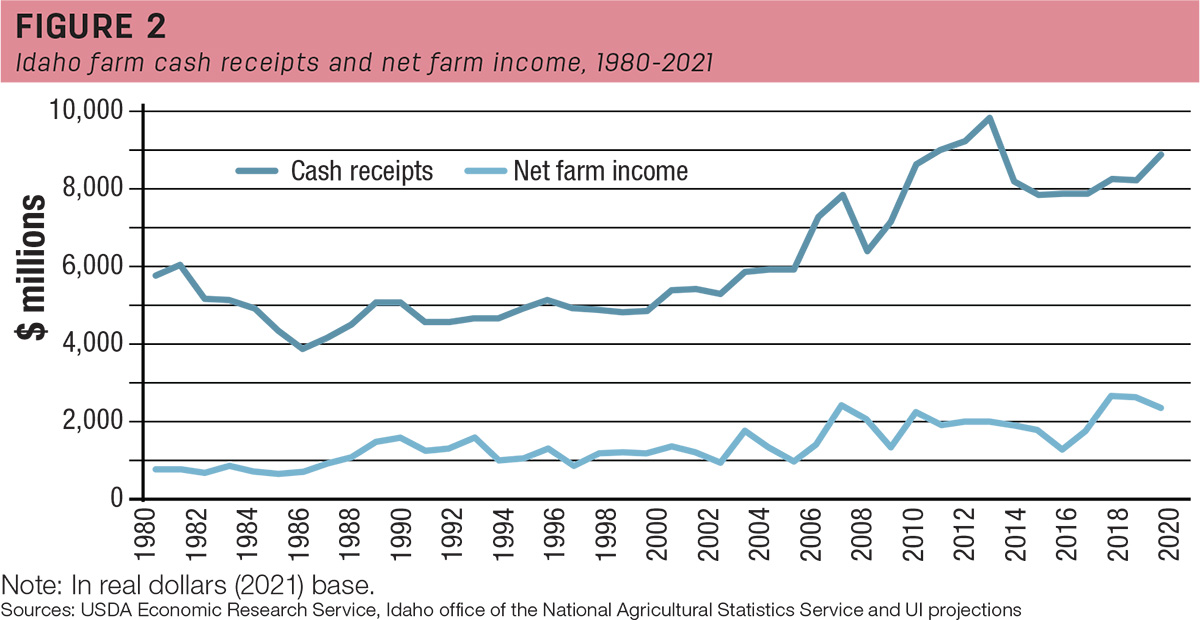
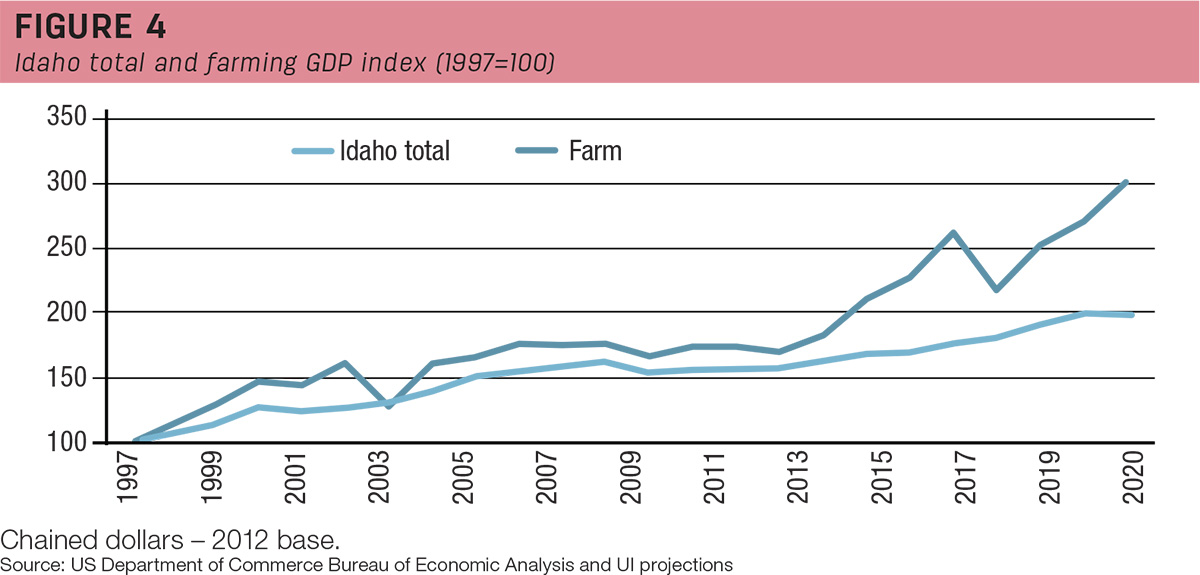

.jpg?height=auto&t=1713304395&width=285)


